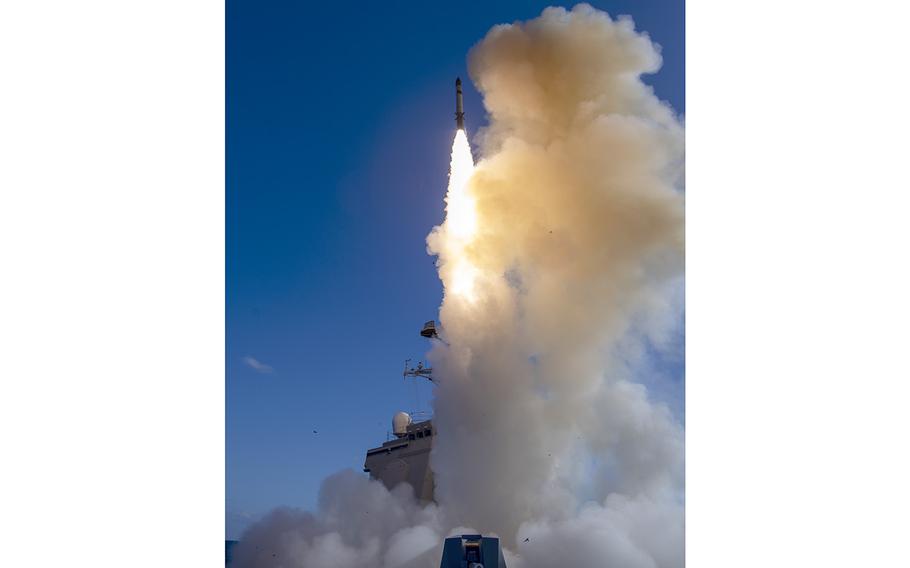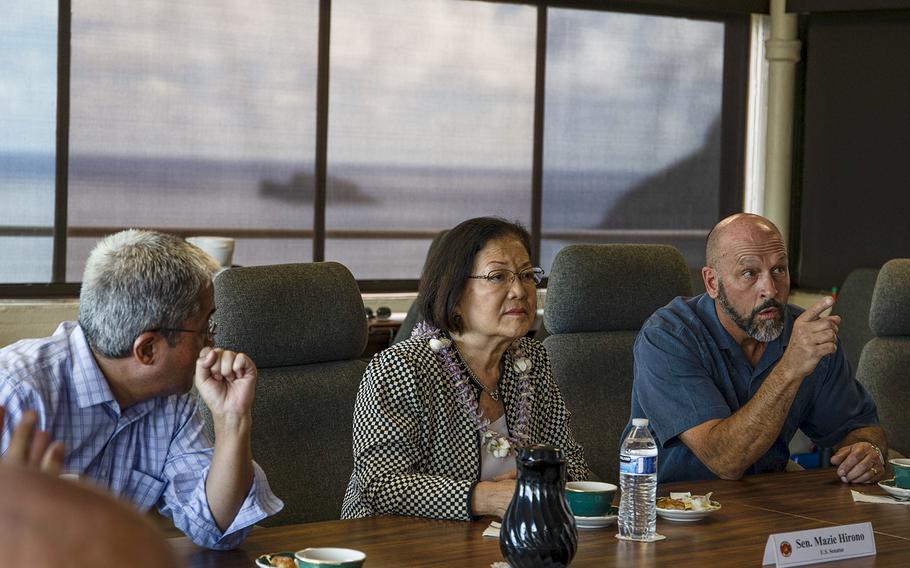
A Standard Missile-3 Block IIA launches from a ship during a 2007 exercise that was directed from the Pacific Missile Range Facility in Kauai, Hawaii. (Missile Defense Agency)
(Tribune News Service) — Sen. Mazie Hirono wants answers from military leaders about missile defense in the islands amid rising tensions in the Pacific, asking senior military brass about the Pentagon’s strategy for defending Hawaii.
U.S. Sen. Mazie Hirono wants answers from military leaders about missile defense in the islands amid rising tensions in the Pacific, asking senior military brass about the Pentagon’s strategy for defending Hawaii.
“Hawaii holds a strategic position in the Pacific with many integral Department of Defense equities, which makes the threat of missile attack particularly acute for the people of Hawaii, “ Hirono said last week at a hearing of the Senate Armed Services Committee. “I’ve been asking for many years now how DoD will ensure Hawaii is defended from missile attack.”
Hirono and fellow members of the Hawaii delegation agreed in 2022 to stop pushing funding for the controversial Homeland Defense Radar-Hawaii. The Pentagon tried to defund and suspend the $1.9 billion project amid rising costs as officials scouted for locations, and strong pushback came from many local residents who said the massive project would threaten habitats for endangered species and Hawaiian cultural sites.
Army and Navy leaders also disagreed over who should give up precious training land to build the facility, while several analysts warned it could become obsolete by the time it was finished and advocated looking into developing space-based programs. The Pentagon launched a review of potential alternative missile defense systems for Hawaii, and members of the delegation said they would await the military’s review before pushing for more funding.
“Ensuring the proper defense of Hawai ‘i remains one of my highest priorities, now as a member of the U.S. House Appropriations Committee’s Subcommittee of Defense, “ Honolulu’s Congressman Ed Case told the Star-Advertiser in a statement. “While we do not yet have the details of the president’s proposed Fiscal Year 2024 defense budget, I’m optimistic given our ongoing discussions with the Defense Department that it will include specific requests to upgrade Hawai ‘i missile defense.”
U.S. Sen. Brian Schatz, who also previously supported the Homeland Defense Radar before withdrawing support in 2022, did not respond to a request for comment. But during the Thursday hearing, Hirono charged that the Pentagon has not kept lawmakers in the loop or adequately addressed their concerns about missile threats.
“I have still not received a brief on the results of that study or the department’s plan for how it intends to protect Hawaii from all types of ... threats from current and future potential adversaries, “ said Hirono.
On Monday the Pentagon released President Joe Biden’s proposed defense budget. The $842 billion budget includes the $9.1 billion Pacific Deterrence Initiative, which a summary said would include “funding for defense of Guam and Hawaii.”
The Missile Defense Agency’s proposed $10.9 billion budget, up from $10.4 billion in 2022, includes $397.6 million to continue the development of a missile defense system for Guam, which is considered a major pillar of Pacific deterrence, and $169.6 million in funding for the Aegis Guam System, a system meant to intercept incoming missiles. But no specific system is noted for Hawaii.
Oahu is the nerve center for all U.S. operations in the region, with U.S. Indo-Pacific Command and the Navy’s vast Pacific Fleet headquartered here. But the Pentagon has been shifting its attention to Guam when it comes to missile defense over concern that the island territory could be particularly vulnerable to attack due to its proximity to Taiwan, the Korean Peninsula and other potential geopolitical flashpoints.
Riki Ellison, founder and chair of the Missile Defense Advocacy Alliance, said it appears the Pentagon wants to essentially move what would have been Homeland Defense Radar-Hawaii to Guam. But he argued that building a ground-based radar on Guam won’t be any easier than it would be in Hawaii.
“They’re going to have to pave the roads, they’re going to have to do all sorts of stuff to fit this architecture, “ said Ellison. “So it’s very curious why we don’t have a capability here in Hawaii and why we think that we still have to wait until that one’s complete to get one here.”
In the absence of a land-based radar, Hawaii is reliant on the Missile Defense Agency’s massive Sea Based X-Band Radar—known to many Hawaii residents as the “golf ball “ for its large white dome. The SBX is currently in Pearl Harbor undergoing repairs and upgrades after 662 days out at sea—the longest it has ever deployed. The mobile radar can deploy anywhere in the Pacific, but critics charge that a narrow field of vision limits its ability to detect missiles in the event that a hostile force launches multiple missiles and decoys.
The Navy also has several warships in Hawaii armed with missile defense systems. During a multinational naval exercise in Hawaii in August, a Navy Arleigh Burke-class destroyer used its Aegis Combat System to practice shooting down ballistic missiles shortly after a North Korean missile test. In a news release the U.S. military said the “ballistic missile search and tracking exercise demonstrated the commitment of the U.S., ( South Korea ), and Japan to furthering trilateral cooperation to respond to (North Korean ) challenges, protecting shared security and prosperity, and bolstering the rules-based international order.”
Ellison said that as tensions escalate between China and Taiwan—a self-ruled island that Beijing considers a rogue province—there is serious concern that China could unleash its missile capabilities during an invasion. Chinese leader Xi Jinpeng has vowed to bring Taiwan under Chinese control by military force if necessary.
The United States has not officially diplomatically recognized Taiwan since normalizing relations with the People’s Republic of China in 1979, but the Taiwan Relations Act of 1979 maintained de facto ties and requires the U.S. to provide Taiwan with weapons to defend itself and “resist any resort to force or other forms of coercion that would jeopardize the security, or the social or economic system, of the people on Taiwan.”
Ellison said that in the event the U.S. military makes moves to protect Taiwan, the situation has the potential to escalate rapidly and that Hawaii’s strategic and logistical military centers like Camp Smith and Joint Base Pearl Harbor-Hickam could become targets. He said that to actually stave off the invasion, commanders might see a strike on Chinese forces across the Taiwan Strait as necessary.
“In most of the war games China plays out, it will take out Guam pretty quickly, “ said Ellison. “But then it goes back to what if we do something on mainland China ? What’s the repercussions ? And that is going to be Hawaii, and that’s going to be the western United States and that’s going to be Alaska.”

U.S. Sen. Mazie Hirono, D-Hawaii, listens to a brief during her visit to Marine Corps Base Hawaii Aug. 28, 2019. (Samantha Sanchez/U.S. Marine Corps)
Hirono told military leaders that she has “serious concerns that there’s not one dedicated person in the Department of Defense with the responsibility to ensure that there is a plan for missile defense of Hawaii. ... I express frustration because every time I ask about missile defense for Hawaii, I don’t get a response.”
Hirono compared the Pentagon’s lack of answers on missile defense to the ongoing political fallout over the 2021 fuel contamination of the Navy’s Oahu water system from the Navy’s World War II-era Red Hill fuel farm. It is set to be defueled by summer 2024, but multiple military agencies are involved in different parts of the response.
The Red Hill crisis has strained relations between island residents and military leaders, with many in the islands reassessing their relationship with the military presence on the island.
Hirono told the military leaders that “as we have seen in the continuing challenges regarding the Red Hill crisis, where there is not one ultimate person ultimately responsible over the planning and execution of an issue as it relates to what needs to happen with Red Hill, it adds to the lack of trust within the community that the military will get things right.”
(c)2023 The Honolulu Star-Advertiser
Visit The Honolulu Star-Advertiser at www.staradvertiser.com
Distributed by Tribune Content Agency, LLC.